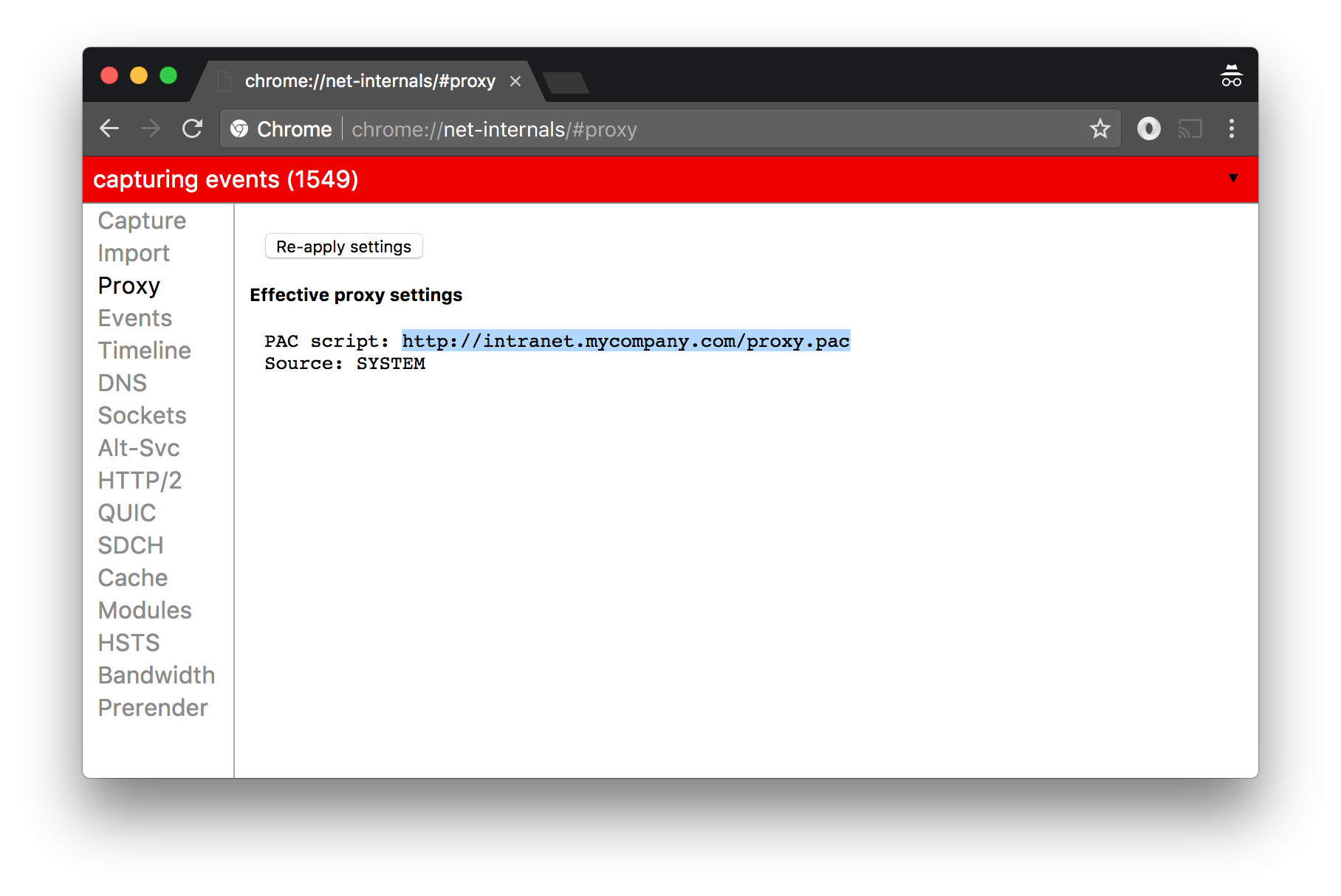proxy-pac-proxy
v1.0.12
Published
Forwarding proxy with support for upstream *proxy.pac* resolution and BASIC authentication
Downloads
15
Readme
proxy-pac-proxy
Forwarding proxy with support for upstream proxy.pac resolution and BASIC authentication
Software development in network environments where Internet access is forced through dynamically configured HTTP proxies is a pain. The simple use of common package managers such as npm, pip, gem or docker -- perhaps in combination with services and repositories on the local network -- requires reverse engineering of a proxy.pac file and the configuration of arbitrarily complicated combinations of the usual *_PROXY environment variables. Worse, if the proxy requires authentication, passwords will quickly spread across environment variables, *_history files and whatnot.
Proxy-pac-proxy tries to alleviate at least some of that pain.
Installation
Note: proxy-pac-proxy requires at least Node v7.6.0
Note2: installation requires access to the public npmjs.com repository. That is straightforward when connected to a public network, but may be tricky in those network environments where proxy-pac-proxy is needed. In the latter case,
npmcan be instructed to access the Internet through a previously discovered HTTP proxy by using the--https-proxyoption. This is needed only at installation time; afterwards proxy-pac-proxy can take care of the problem
To install proxy-pac-proxy on your system run:
$ npm install -g proxy-pac-proxyQuick Start
Export the proxy.pac URL (optional, but if the environment variable
is not set, the URL will need to be provided on the command line with
the -u option):
$ export PROXYPACPROXY_URL=http://intranet.mycompany.com/proxy.pacStart the forwarding proxy server with authentication:
$ proxy-pac-proxy start -A
Username: joedoe
Password for joedoe: [hidden]
Proxy succesfully started.
You may configure your shell by running the `proxy-pac-proxy env` command.From this point on, in any shell it will be possible to automatically configure all the appropriate *_PROXY environment variables for steering traffic through the new forwarding proxy:
$ eval $(proxy-pac-proxy env)Test:
$ curl -v http://example.com
* Rebuilt URL to: http://example.com/
* Trying 127.0.0.1...
* TCP_NODELAY set
* Connected to (nil) (127.0.0.1) port 8079 (#0)
> GET http://example.com/ HTTP/1.1
> Host: example.com
> User-Agent: curl/7.52.1
> Accept: */*
> Proxy-Connection: Keep-Alive
>
< HTTP/1.1 200 OK
< date: Sat, 30 Sep 2017 09:16:36 GMT
< etag: "359670651+ident"
< vary: Accept-Encoding
< server: ECS (dca/24D1)
< expires: Sat, 07 Oct 2017 09:16:36 GMT
< x-cache: HIT, HIT from 10.29.176.45
< content-type: text/html
< cache-control: max-age=604800
< last-modified: Fri, 09 Aug 2013 23:54:35 GMT
< content-length: 1270
< proxy-connection: Keep-Alive
< Connection: keep-alive
< ...Retrieving the proxy.pac URL
The proxy.pac URL is often configured automatically, in ways that depend on the operating system and the IT/network administration policies (e.g. autodiscovery, remote admin...). One simple cross-platform way to retrieve the URL is on the chrome://net-internals tab in Chrome:

Usage
proxy-pac-proxy start
Start a local instance of a forwarding proxy that can be controlled through the stop and env commands.
$ proxy-pac-proxy start --help
proxy-pac-proxy start [options]
Options:
--url, -u The proxy.pac URL [string] [required]
--address, -a The local address the proxy will bind to
[string] [default: "127.0.0.1"]
--port, -p The local port the proxy will bind to
[number] [default: 8079]
--authenticate, -A Prompt for username and password for proxy
authentication [boolean] [default: false]
--username, --user, -U The username for proxy authentication [string]
--password, --pass, -P The password for proxy authentication [string]
--foreground, -f Run in foreground [boolean] [default: false]
-h, --help Show help [boolean]
-v, --version Show version number [boolean]proxy-pac-proxy stop
Stop the local forwarding proxy instance.
$ proxy-pac-proxy stop --help
proxy-pac-proxy stop [options]
Options:
--address, -a The local address the proxy is bound to
[string] [default: "127.0.0.1"]
--port, -p The local port the proxy is bound to
[number] [default: 8079]
-h, --help Show help [boolean]
-v, --version Show version number [boolean]proxy-pac-proxy env
Display the commands to configure the shell environment.
$ proxy-pac-proxy env --help
proxy-pac-proxy env [options]
Options:
--address, -a The local address the proxy is bound to
[string] [default: "127.0.0.1"]
--port, -p The local port the proxy is bound to
[number] [default: 8079]
--reset, -r Display commands to reset the environment
[boolean] [default: false]
-h, --help Show help [boolean]
-v, --version Show version number [boolean]Limitations
Only supports BASIC Authentication
Only slightly more secure than storing credentials in environment variables. With BASIC authentication Base64-encoded passwords are transmitted in clear
- Do not use authentication unless you totally trust the local
network administrator; if that's not the case, then leave
authentication unset (i.e. don't use
-Aor-Uoptions) and rely on application-based authentication
- Do not use authentication unless you totally trust the local
network administrator; if that's not the case, then leave
authentication unset (i.e. don't use
The
envcommand only displays commands for bash. Commands for other shells can be easily derived, but at this point that's a job that must be done manually
